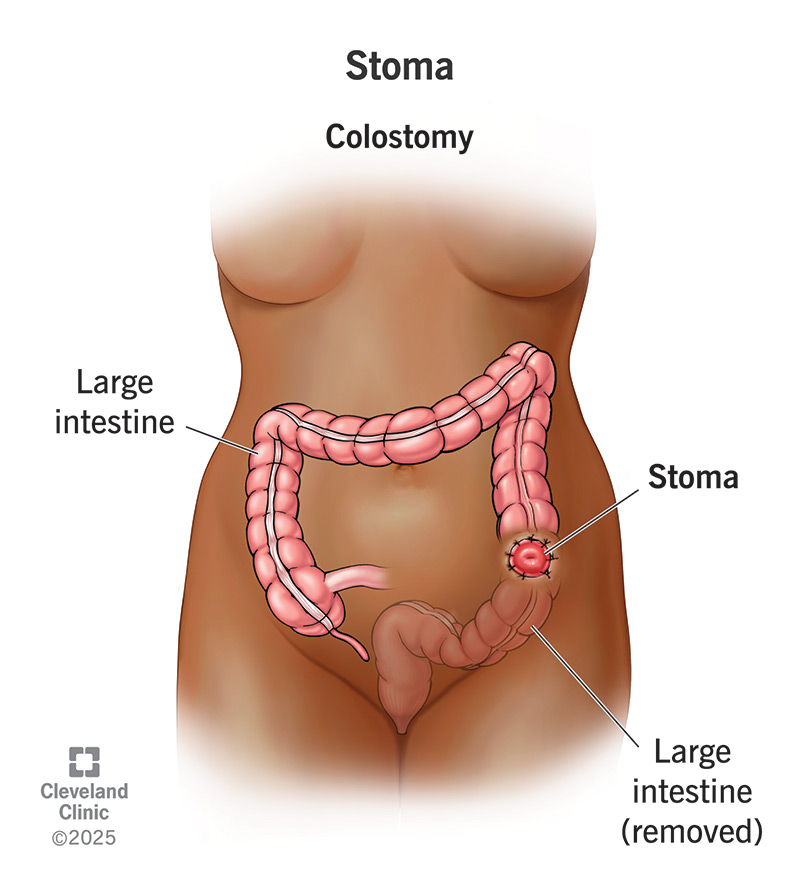If you have ostomy surgery on your bowel or urinary system, your surgeon will create a stoma in your abdomen. This is a new opening for waste (poop or pee) to come out. You’ll connect your stoma to an ostomy bag to collect the waste. Your stoma may be temporary or permanent.
Advertisement
Cleveland Clinic is a non-profit academic medical center. Advertising on our site helps support our mission. We do not endorse non-Cleveland Clinic products or services. Policy

A stoma is a surgically created opening on the outside of your body that connects to an organ on the inside. The operation to create this opening and connection is called an ostomy. You might have a stoma in your abdomen if part of your intestine or urinary tract isn’t working properly and you need a different way for waste to come out. Less commonly, some people have a neck stoma to help them breathe.
Advertisement
Cleveland Clinic is a non-profit academic medical center. Advertising on our site helps support our mission. We do not endorse non-Cleveland Clinic products or services. Policy
Types of ostomies with stomas include:
Common reasons you might need an ostomy and stoma include:
A stoma can be temporary or permanent. Sometimes, you only need one for a few months while your organ heals. After that, your surgeon can do an ostomy reversal and close your stoma. In other cases, you might need to have a stoma for life. Whether it’s temporary or permanent, learning to live with a stoma can be a big adjustment. But it can also be freeing, relieving you from a disabling disease.
An abdominal stoma is a direct opening from the outer wall of your belly to the inside of your intestine or urinary tract. Your surgeon forms your stoma by creating an opening in the surface of your belly, then bringing a part of your intestine or ureter to the surface and stitching it there. Poop or pee will now come out of your stoma and collect into a pouch that you wear on your belly (ostomy bag or stoma bag).
Advertisement
A neck stoma is an opening into your throat to help you breathe. It also allows your provider to remove fluids and mucus from your respiratory system. This type of stoma has different supplies and care needs.
Your stoma is a roundish opening in your abdomen, about an inch to two inches wide. The exact location can vary, depending on the type. It’s pink or red in color and looks like moist tissue, similar to the inside of your mouth. When it’s new, it may appear swollen, but over time, it will shrink. Stomas can look a little different from person to person. Some lie flat against your skin, and some stick out a little.
Your stoma itself doesn’t have any nerve endings or feel any sensation. After your new ostomy heals, you shouldn’t feel it at all. But you might have feelings about having one. A stoma is a significant change in how your body works and looks. It’s normal to feel self-conscious or anxious about it at first. It might help to talk with a therapist or connect with a support network of other people living with ostomies.
When you have a new stoma, you’ll meet with a healthcare specialist called a stomal therapy nurse or wound ostomy continence nurse. They’ll teach you all about how to care for your stoma, including:
Your stoma nurse can also advise you on taking care of your mental health as you adjust to life with a stoma. They can connect you with support groups and other resources to improve your confidence.
Possible complications with a stoma include:
Advertisement
Check in with your healthcare provider if:
Living with a stoma takes a little extra planning when it comes to certain things. For example:
Advertisement
Living with a stoma can take some getting used to. But it shouldn’t stop you from living a full life. You can do all the same things you used to do with a stoma — from travelling and swimming to having sex and dressing up. There’s a world of products available for people living with ostomies to help conceal and protect their stomas. And there’s a world of others living with stomas who you can connect with and learn from.
Advertisement
Some conditions like rectal and colon cancer, Crohn’s disease and ulcerative colitis may require colorectal surgery. Cleveland Clinic has the expert care you need.

Last reviewed on 06/14/2025.
Learn more about the Health Library and our editorial process.